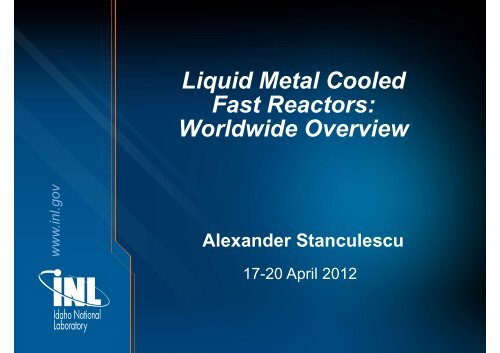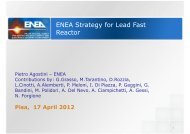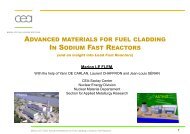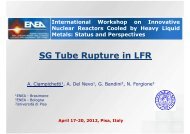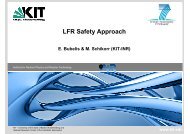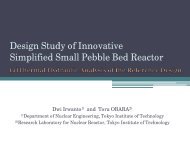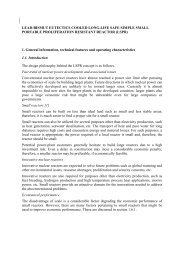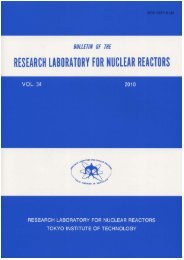Liquid Metal Cooled Fast Reactors: Worldwide Overview Worldwide ...
Liquid Metal Cooled Fast Reactors: Worldwide Overview Worldwide ...
Liquid Metal Cooled Fast Reactors: Worldwide Overview Worldwide ...
You also want an ePaper? Increase the reach of your titles
YUMPU automatically turns print PDFs into web optimized ePapers that Google loves.
<strong>Liquid</strong> <strong>Metal</strong> <strong>Cooled</strong><br />
<strong>Fast</strong> <strong>Reactors</strong>:<br />
<strong>Worldwide</strong> <strong>Overview</strong><br />
www.inl.gov<br />
Alexander Stanculescu<br />
17-20 April 2012
<strong>Fast</strong>!<br />
Source: Astérix le Gaulois (René Goscinny, Albert Uderzo)<br />
International Workshop on Innovative Nuclear <strong>Reactors</strong> <strong>Cooled</strong> by Heavy <strong>Liquid</strong><br />
<strong>Metal</strong>s: Status And Perspectives, Pisa, Italy 17-20 April 2012<br />
2
Thermal vs. <strong>Fast</strong><br />
fission in fissile<br />
capture in fertile<br />
LWRs use low enr U,<br />
HWRs even nat U<br />
• Fuel temperature increase ⇒<br />
Doppler broadening<br />
⇒ Loss of reactivity<br />
• Loss of liquid coolant<br />
⇒ loss of moderator<br />
⇒ loss of reactivity<br />
fission in fissile<br />
fissile to fertile concentration<br />
fission/capture and neutron multiplicity<br />
BREEDING<br />
• Locally positive void effect<br />
• Doppler effect smaller<br />
• Fuel expansion ⇒ loss of reactivity<br />
• Power increase ⇒ loss of reactivity<br />
• Not in most reactive geometry<br />
• Smaller β eff ⇒ less margin to prompt<br />
criticality<br />
International Workshop on Innovative Nuclear <strong>Reactors</strong> <strong>Cooled</strong> by Heavy <strong>Liquid</strong> <strong>Metal</strong>s:<br />
Status And Perspectives, Pisa, Italy 17-20 April 2012<br />
3
Another Way to Show <strong>Fast</strong> Reactor<br />
Breeding Potential<br />
Isotope<br />
235<br />
U<br />
239<br />
Pu<br />
233<br />
U<br />
Spectrum Thermal <strong>Fast</strong> Thermal <strong>Fast</strong> Thermal <strong>Fast</strong><br />
σ f (barn) 582 1.81 743 1.76 531 2.79<br />
σ c (barn) 101 0.52 270 0.46 46 0.33<br />
α=σ c /σ f 0.17 0.29 0.36 0.26 0.09 0.12<br />
ν 2.42 2.43 2.87 2.94 2.49 2.53<br />
η=νσ f /σ a<br />
Neutron Multiplicity<br />
2.07 1.88 2.11 2.33 2.29 2.27<br />
β eff (pcm) 650 210 280<br />
Breeding Requires η = ν<br />
1 + α > 2<br />
International Workshop on Innovative Nuclear <strong>Reactors</strong> <strong>Cooled</strong> by Heavy <strong>Liquid</strong> <strong>Metal</strong>s:<br />
Status And Perspectives, Pisa, Italy 17-20 April 2012 4
… and Minor Actinides Utilization Potential<br />
Isotope<br />
Thermal<br />
α = σ c / σ f<br />
<strong>Fast</strong><br />
235<br />
U 0.22 0.29<br />
238 U 8.3 7.5<br />
239<br />
Pu 0.58 0.3<br />
240<br />
Pu 396.6 1.6<br />
241<br />
Pu 0.40 0.19<br />
242<br />
Pu 65.5 1.8<br />
237<br />
Np 63 5.3<br />
241<br />
Am 100 7.4<br />
243 Am 111 8.6<br />
244<br />
Cm 16 1.4<br />
245<br />
Cm 0.15 0.18<br />
α = σ c<br />
σ f<br />
is more favorable to minor actinides<br />
fission in the fast spectrum.<br />
International Workshop on Innovative Nuclear <strong>Reactors</strong> <strong>Cooled</strong> by Heavy <strong>Liquid</strong> <strong>Metal</strong>s:<br />
Status And Perspectives, Pisa, Italy 17-20 April 2012<br />
5
<strong>Fast</strong> <strong>Reactors</strong> (FRs) Offer Great Potential<br />
Increased uranium utilization<br />
– High fission neutron yield per neutron absorbed in 239 Pu in a fast<br />
spectrum<br />
– At 2–3% fuel cycle losses and 100–200 GWd/t burnup it is possible to<br />
fission more than 80% of the natural uranium resources<br />
– FR thermal efficiency ~ 0.4 (~ 0.3 for a thermal reactor)<br />
amount of energy that can be recovered per unit uranium mass is<br />
greater<br />
Higher nuclear power growth rates with available resources<br />
thanks to fissile material breeding<br />
– Advanced denser fuels (carbide, nitride and metal) have higher<br />
breeding potential compared to oxide fuels, allowing even higher<br />
nuclear power growth rates<br />
International Workshop on Innovative Nuclear <strong>Reactors</strong> <strong>Cooled</strong> by Heavy <strong>Liquid</strong> <strong>Metal</strong>s:<br />
Status And Perspectives, Pisa, Italy 17-20 April 2012<br />
6
FRs Offer Great Potential (cont’d)<br />
Utilization of used fuel and reduction of waste<br />
– Long-lived minor actinides ( 237 Np, 241 Am, 242 Am, 243 Am and 244 Cm), posing<br />
radiological hazard in the repository, are produced in thermal reactors since<br />
Σ cap ˃ Σ fiss<br />
– MA are produced at a lower rate in FRs, due to smaller Σ cap /Σ fiss , and even<br />
utilized through fission<br />
In FRs, even with multiple recycle, the Pu isotopic composition can be<br />
maintained at a nearly constant value<br />
Potential for thorium fuel cycle 233 U breeding with low 232 U content<br />
– 232 U contamination (strong source of γ radiation) in a thorium-fuelled thermal<br />
reactor: 2000 - 4000 ppm, vs. 500 -1000 ppm in FR<br />
Utilization of fission products and other radioactive isotopes<br />
– Production of fission products having commercial value in the FR cycle, e.g.<br />
137<br />
Cs (~31% of total Cs yield); 90 Sr (~60% of total Sr yield; Pd (produced nearly<br />
free of radioactive contamination); Rh and Ru (both radioactive but decaying to<br />
acceptable levels within a few years); 212 Pb; 212 Bi; 223 Ra; 227 Ac<br />
International Workshop on Innovative Nuclear <strong>Reactors</strong> <strong>Cooled</strong> by Heavy <strong>Liquid</strong><br />
<strong>Metal</strong>s: Status And Perspectives, Pisa, Italy 17-20 April 2012 7
<strong>Fast</strong> Reactor Coolants<br />
International Workshop on Innovative Nuclear <strong>Reactors</strong> <strong>Cooled</strong> by Heavy <strong>Liquid</strong><br />
<strong>Metal</strong>s: Status And Perspectives, Pisa, Italy 17-20 April 2012 8
Conclusion<br />
Sustainability<br />
and breeding<br />
recycle used fuel utilization<br />
fast reactor indispensable<br />
For long-term sustainable nuclear power closed fuel cycle<br />
with fast reactors will constitute the main nuclear energy<br />
system<br />
International Workshop on Innovative Nuclear <strong>Reactors</strong> <strong>Cooled</strong> by Heavy <strong>Liquid</strong><br />
<strong>Metal</strong>s: Status And Perspectives, Pisa, Italy 17-20 April 2012 9
WORLDWIDE CLOSE TO 400 FR-YEARS CUMULATED OPERATION<br />
China<br />
– CEFR (23 MWe) July 2010<br />
India<br />
– FBTR (13 MWe) 1985<br />
– PFBR (500 MWe) 2011/12<br />
Japan<br />
– Joyo (140 MWth) 1977<br />
– Monju (280 MWe) 1994,<br />
May 2010<br />
Russia (USSR)<br />
– BR10 (8 MWth) 1958 – 2003<br />
– BOR60 (12 MWe) 1968<br />
– BN350 (130 MWe) 1972 – 99<br />
– BN600 (600 MWe) 1980<br />
– BN800 (870 MWe) ~2013<br />
EU (D, F, UK)<br />
– Rapsodie (40 MWth) 1967 – 83<br />
USA<br />
– DFR (15 MWe) 1959 – 77<br />
– KNK-II (20 MWe) 1972 – 91<br />
– Phénix (250 MWe) 1973 – 2010<br />
– PFR (250 MWe) 1974 – 94<br />
– SNR300 (300 MWe) not started<br />
– Superphénix (1200 MWe) 1986 – 98<br />
– EFR Proj. (1580 MWe), cancelled 98<br />
– EBR-I (a few 100s We) 1951 – 64<br />
– EBR-II (20 MWe) 1961 – 1998<br />
– FFTF (400 MWth) 1980 – 1996<br />
– CRBR Proj.(380 MWe), cancelled 83<br />
International Workshop on Innovative Nuclear <strong>Reactors</strong> <strong>Cooled</strong> by Heavy <strong>Liquid</strong> <strong>Metal</strong>s:<br />
Status And Perspectives, Pisa, Italy 17-20 April 2012 10
Phénix<br />
2010 shut down > 35 yrs<br />
Technology demonstrator<br />
and R&D support<br />
1999 – 2002 plant<br />
renovations and safety<br />
upgrades 720 EFPD<br />
lifetime extension to support<br />
French long-lived radioactive<br />
waste management<br />
programme<br />
2003 – 2009 satisfactory/better than satisfactory operation broke<br />
own grid connection time in 2007, operating cycle length, & electrical<br />
production run without shutdown records<br />
2009 – 2010 end-of-life tests at low and zero power (core physics,<br />
thermal hydraulics, fuel issues, investigations of the 1989/1990 negative<br />
reactivity transients) V&V&Q of FR data, codes, methodologies<br />
International Workshop on Innovative Nuclear <strong>Reactors</strong> <strong>Cooled</strong> by Heavy <strong>Liquid</strong><br />
<strong>Metal</strong>s: Status And Perspectives, Pisa, Italy 17-20 April 2012 11
Superphénix<br />
7 Sep 1985 first criticality<br />
14 Jan 1986 first grid connection<br />
Storage drum sodium leak, first reactor shutdown period May 1987 –<br />
January 1989<br />
Air intake in argon circuit causing primary sodium oxidation beyond<br />
allowable limits, second reactor shutdown period July 1990 – July 1994<br />
20 April 1998 shutdown by government order<br />
8.3 TW el ×h produced<br />
53 months of normal operation (disregarding unplanned outages due to<br />
incidents)<br />
– 8 months start-up tests<br />
– 34 months of power production<br />
– 11 months of planned outages for refuelling, in-service inspection<br />
and maintenance<br />
International Workshop on Innovative Nuclear <strong>Reactors</strong> <strong>Cooled</strong> by Heavy <strong>Liquid</strong><br />
<strong>Metal</strong>s: Status And Perspectives, Pisa, Italy 17-20 April 2012 12
Superphénix, cont’d<br />
International Workshop on Innovative Nuclear <strong>Reactors</strong> <strong>Cooled</strong> by Heavy <strong>Liquid</strong><br />
<strong>Metal</strong>s: Status And Perspectives, Pisa, Italy 17-20 April 2012 13
FBTR<br />
In operation since Oct 1985 over 330 GWh (th)/10 GWh (el)<br />
Efforts to attain design thermal power target (40 MW for original MOX<br />
fuelled core) P th increased from 11 MW [initial (Pu-U)C core<br />
rating] to 19 MW [(Pu-U)C with lower Pu/U]<br />
165 GWd/t Mark I fuel peak BU, no failure<br />
Several system upgrades and modifications additional 12 full<br />
power years expected<br />
FBTR’s mission<br />
– Irradiation tests for Indian Pressurized Heavy Water <strong>Reactors</strong><br />
(PHWRs) and Prototype <strong>Fast</strong> Breeder Reactor (PFBR)<br />
– Physics and engineering experiments V&V&Q of FR data, codes,<br />
methodologies<br />
International Workshop on Innovative Nuclear <strong>Reactors</strong> <strong>Cooled</strong> by Heavy <strong>Liquid</strong><br />
<strong>Metal</strong>s: Status And Perspectives, Pisa, Italy 17-20 April 2012<br />
14
Joyo<br />
2006 ANS Nuclear Historic Landmark Award"<br />
30 th anniversary on 24 April 2007<br />
Joyo’s mission sodium cooled FR development various<br />
irradiation tests and PIE successfully conducted<br />
During 15 th periodical inspection (2007) obstacle found in the in-vessel<br />
storage rack<br />
Restoration works:<br />
– Replacement of upper core structure<br />
– Retrieval of irradiation test device<br />
“MARICO-2” Development of<br />
sodium cooled FR in-vessel<br />
inspection and repair techniques<br />
International Workshop on Innovative Nuclear <strong>Reactors</strong> <strong>Cooled</strong> by Heavy <strong>Liquid</strong><br />
<strong>Metal</strong>s: Status And Perspectives, Pisa, Italy 17-20 April 2012 15
MONJU<br />
First criticality April 1994<br />
8 December 1995<br />
sodium-leak incident in<br />
the sec. coolant system,<br />
shutdown<br />
8 May 2010 restart after<br />
more than 14 yrs and<br />
comprehensive reviews of<br />
the validity of fast breeder<br />
reactor development in<br />
Japan<br />
-Verification of entire plant safety and soundness<br />
-Plant modification work against sodium leakage<br />
-Improvement of the anti-seismic margins<br />
International Workshop on Innovative Nuclear <strong>Reactors</strong> <strong>Cooled</strong> by Heavy <strong>Liquid</strong><br />
<strong>Metal</strong>s: Status And Perspectives, Pisa, Italy 17-20 April 2012 16
BOR-60<br />
1968: start of operation<br />
2009: second lifetime extension till 2014<br />
Small number of unscheduled shutdowns (1 -2 events per year)<br />
Bor-60 experimental and power reactor<br />
– Fuel and material irradiation tests<br />
– Safety, I&C, and sodium technology experimental programs<br />
International Workshop on Innovative Nuclear <strong>Reactors</strong> <strong>Cooled</strong> by Heavy <strong>Liquid</strong> <strong>Metal</strong>s:<br />
Status And Perspectives, Pisa, Italy 17-20 April 2012 17
BN-350<br />
750 MW th (200 MW el ) and water desalination<br />
First criticality 29 November 1972<br />
Power operation 16 July 1973<br />
Initially, derated operation (design thermal rating 1000 MW) due to<br />
unsatisfactory operation of the steam generators<br />
Excessive heat rating of the fuel rods and considerable shape variation<br />
of core structural components core modernization & new<br />
structural materials solved problems<br />
Availability of stand-by components (six loops) & ability to operate with<br />
3-5 loops ensured stable operation of the plant repair and<br />
replacement work on steam generators carried out without shutting<br />
down the reactor<br />
Shutdown June 1994<br />
International Workshop on Innovative Nuclear <strong>Reactors</strong> <strong>Cooled</strong> by Heavy <strong>Liquid</strong><br />
<strong>Metal</strong>s: Status And Perspectives, Pisa, Italy 17-20 April 2012 18
BN-600<br />
26 February 1980 first criticality<br />
8 April 1980 grid connection<br />
December 1981 full power (600 MW el )<br />
As of 31 December 2009<br />
– Power operation exceeded 206,000 hrs<br />
– Over 112.5 TW el ×h produced<br />
Lifetime extended to 31 March 2020<br />
>30 years successful operation<br />
Sodium cooled FR technology attained industrial maturity<br />
Replacement and repair of sodium components, including pumps and<br />
steam generators mastered<br />
Once personnel is trained to master specific features of sodium<br />
technology, these features have no significant influence on safety and<br />
operational parameters of the power plant<br />
International Workshop on Innovative Nuclear <strong>Reactors</strong> <strong>Cooled</strong> by Heavy <strong>Liquid</strong> <strong>Metal</strong>s:<br />
Status And Perspectives, Pisa, Italy 17-20 April 2012<br />
19
EBR-II<br />
November 1963 first criticality<br />
August 1964 grid connection<br />
Demonstration sodium cooled FR power plant (62.5 MW th / 19 MW el )<br />
Demonstrate closed fuel cycle for U alloy fuel<br />
Fuels and materials irradiation tests<br />
Safety experiments (decay heat removal, operation in transient<br />
overpower conditions, and run-beyond-cladding-breach modes)<br />
Integral <strong>Fast</strong> Reactor (IFR) test bed (U-Pu alloy fuel) 1984 – 1994<br />
Actinide irradiation tests of actinide burning<br />
Shutdown 1994 due to the termination of the DOE FR development<br />
program<br />
International Workshop on Innovative Nuclear <strong>Reactors</strong> <strong>Cooled</strong> by Heavy <strong>Liquid</strong><br />
<strong>Metal</strong>s: Status And Perspectives, Pisa, Italy 17-20 April 2012 20
FFTF<br />
Sodium cooled loop-type experimental FR (400 MW th ) to develop and<br />
test advanced fuels and materials<br />
First criticality 9 February 1980<br />
Full power operation 21 December 1980<br />
Operated safely and successfully as an irradiation facility till late<br />
1992<br />
Driver assemblies routinely reached peak burnups of 90 – 100<br />
000 MWd/t with only one fuel failure out of ~40 000 fuel pins<br />
1987 – 1992 core demonstration test (6 blanket and 10 driver<br />
assemblies), cladding and wrapper made from low-swelling alloy HT-<br />
9, 238 000 MWd/t peak burnups without failure<br />
Endurance tests to obtain cladding breaches: pins easily identified<br />
(using EBR-II gas-tag method)<br />
International Workshop on Innovative Nuclear <strong>Reactors</strong> <strong>Cooled</strong> by Heavy <strong>Liquid</strong> <strong>Metal</strong>s:<br />
Status And Perspectives, Pisa, Italy 17-20 April 2012<br />
21
FFTF, cont’d<br />
Plant tests to study passive safety characteristics of oxide-fuelled sodium<br />
cooled FR (static and dynamic tests over a broad range of power, flow<br />
and temperature conditions, including demonstration of stable operation<br />
at low power under natural circulation cooling conditions)<br />
Development and testing of passive safety enhancement device GEM<br />
(gas expansion module) to offset the excess reactivity in ULOF<br />
conditions<br />
GEM effectiveness demonstrated: primary pumps stopped at 50% power<br />
(200 MWt) normal control-rod scram response disabled GEMs<br />
and inherent core reactivity feedback effects took the reactor sub-critical<br />
with only a short 85°C rise in sodium outlet temperature<br />
Primary & secondary pumps operated for over 200’000 hrs, no major<br />
maintenance required<br />
IHX thermal performance unchanged from initial values<br />
Electromagnetic pumps required little maintenance except for one that<br />
developed a pin-hole leak (flow tube deformation due to sodium<br />
freeze/thaw cycles & cavitation/erosion at high sodium flow; promptly &<br />
easily replaced<br />
International Workshop on Innovative Nuclear <strong>Reactors</strong> <strong>Cooled</strong> by Heavy <strong>Liquid</strong><br />
<strong>Metal</strong>s: Status And Perspectives, Pisa, Italy 17-20 April 2012 22
PFR<br />
250 MW el (600 MW th ), sodium cooled, MOX fuelled, stainless steel<br />
clads, mechanical centrifugal pumps, highly-rated tube-in-shell SGs<br />
3 March 1974 first criticality<br />
31 March 1994 final shutdown<br />
Operating history of PFR conveniently divided into two decades:<br />
- 1974 – 1984: electrical output limited, mainly because of a series of<br />
leaks in the tube-to-tubeplate welds of the SGs (12% highest load<br />
factor in 1978)<br />
- 1984 – 1994: SG weld problems solved, plant performance<br />
improvement (56.5% load factor in the final year of operation); 18-<br />
month outage in 1991/92 due to oil leakage from a primary pump<br />
bearing into primary sodium<br />
International Workshop on Innovative Nuclear <strong>Reactors</strong> <strong>Cooled</strong> by Heavy <strong>Liquid</strong> <strong>Metal</strong>s:<br />
Status And Perspectives, Pisa, Italy 17-20 April 2012<br />
23
Looking Ahead: <strong>Fast</strong> Reactor R&D&D<br />
Renewed interest in nuclear energy (?)<br />
Sustainability ⇒ spent fuel utilization and breeding returning to centre stage<br />
⇒ fast reactor necessary linchpin<br />
<strong>Fast</strong> reactor deployment likely to be accelerated<br />
– Restart in May 2010 of the industrial prototype Monju (Japan)<br />
– Commissioning, at the time horizon 2011 – 2023, of power fast reactors<br />
in India (7 PFBRs, 3.5 GWe total capacity)<br />
– SVBR-100 (Pb-Bi cooled) commissioning planned ~2023 (joint venture<br />
between Rosatom and RUSAL)<br />
– Planned construction ~2020 of the prototype fast reactor ASTRID<br />
(France)<br />
– Construction projects in China, India, Russia, Japan and the Republic of<br />
Korea<br />
Experimental fast reactor construction projects<br />
– Belgian government approval for MYRRHA construction<br />
– Construction of MBIR replacing BOR-60 in Dimitrovgrad<br />
International Workshop on Innovative Nuclear <strong>Reactors</strong> <strong>Cooled</strong> by Heavy <strong>Liquid</strong><br />
<strong>Metal</strong>s: Status And Perspectives, Pisa, Italy 17-20 April 2012<br />
24
First Criticality of China’s 25 Mwe Experimental<br />
<strong>Fast</strong> Reactor (CEFR) 26 July 2010<br />
International Workshop on Innovative Nuclear <strong>Reactors</strong> <strong>Cooled</strong> by Heavy <strong>Liquid</strong> <strong>Metal</strong>s:<br />
Status And Perspectives, Pisa, Italy 17-20 April 2012<br />
25
PFBR, Kalpakkam: Erection of Vessels<br />
Safety vessel into reactor vault<br />
Main vessel into safety vessel<br />
Inner vessel into main vessel<br />
Handling of SV by heavy duty crane<br />
Grid plate into main vessel<br />
Thermal baffle into main vessel<br />
International Workshop on Innovative Nuclear <strong>Reactors</strong> <strong>Cooled</strong> by Heavy <strong>Liquid</strong><br />
<strong>Metal</strong>s: Status And Perspectives, Pisa, Italy 17-20 April 2012 26
PFBR, Kalpakkam: Erection of Roof Slab<br />
International Workshop on Innovative Nuclear <strong>Reactors</strong> <strong>Cooled</strong> by Heavy <strong>Liquid</strong><br />
<strong>Metal</strong>s: Status And Perspectives, Pisa, Italy 17-20 April 2012 27
Russia’s BN-800, Beloyarsk Site, Sept 2008<br />
Commissioning Planned ~2013<br />
International Workshop on Innovative Nuclear <strong>Reactors</strong> <strong>Cooled</strong> by Heavy <strong>Liquid</strong><br />
<strong>Metal</strong>s: Status And Perspectives, Pisa, Italy 17-20 April 2012 28
Requirements for Next (Advanced)<br />
LMFR Prototype (e.g. ASTRID)<br />
Sustainability<br />
– Efficient uranium utilization (closed fuel cycle)<br />
– Improve ultimate radioactive waste form (decay heat, radiotoxic inventory…)<br />
– Enhanced non-proliferation<br />
Robust safety demonstration matching at least Gen III safety criteria<br />
– Enhanced prevention of severe core damage<br />
– Practical exclusion of large energy release in hypothetical core meltdown<br />
– Contain the risk due to sodium’s chemical reactivity<br />
– Robustness to external hazards<br />
Economic competitiveness<br />
– Reduction of capital cost and investment risk to about Gen III level<br />
– Improved plant operability (ISI&R, target of 90% availability, …)<br />
– Long lifetime (60 years)<br />
International Workshop on Innovative Nuclear <strong>Reactors</strong> <strong>Cooled</strong> by Heavy <strong>Liquid</strong><br />
<strong>Metal</strong>s: Status And Perspectives, Pisa, Italy 17-20 April 2012<br />
29
NEW GENERATION OF SFR<br />
ASTRID (~2020)<br />
– 600 MWe<br />
– Test-bed for innovation<br />
(systems, technologies)<br />
– Capability for materials<br />
and fuel testing<br />
– Advanced recycle modes<br />
demonstrations<br />
(U/Pu, MA)<br />
– Improved U utilization<br />
– Improved waste form<br />
International Workshop on Innovative Nuclear <strong>Reactors</strong> <strong>Cooled</strong> by Heavy <strong>Liquid</strong> <strong>Metal</strong>s:<br />
Status And Perspectives, Pisa, Italy 17-20 April 2012<br />
30
GEN IV SFR: JAEA SODIUM COOLED FAST<br />
REACTOR (JSFR)<br />
Power<br />
Parameter<br />
Specifications<br />
3570 MWt / 1500 MWe<br />
Number of loops 2<br />
Primary sodium outlet<br />
temperature and flow rate<br />
550 / 395 °C<br />
3.24 x 10 7 kg/h/loop<br />
Secondary<br />
pump<br />
SG<br />
Secondary sodium<br />
temperature and flow rate<br />
Main steam temperature<br />
and pressure<br />
Feed water temperature<br />
and flow rate<br />
520 / 335 ° C<br />
2.70 x 10 7 kg/h/loop<br />
497 °C<br />
19.2 MPa<br />
240 °C<br />
5.77 x 10 6 kg/h<br />
Plant efficiency ~42%<br />
Fuel type<br />
TRU-MOX<br />
Breeding ratio Break even (1.03), 1.1, 1.2<br />
Cycle length<br />
26 months or less, 4 batches<br />
Integrated<br />
Pump-IHX<br />
Reactor Vessel<br />
Reactor Core<br />
Courtesy H. Negishi, JAEA<br />
International Workshop on Innovative Nuclear <strong>Reactors</strong> <strong>Cooled</strong> by Heavy <strong>Liquid</strong><br />
<strong>Metal</strong>s: Status And Perspectives, Pisa, Italy 17-20 April 2012 31
GEN IV SFRs: Small (SMFR) and<br />
Medium Size (KALIMER)<br />
SMFR<br />
KALIMER<br />
AHX<br />
Chimney<br />
PDRC<br />
piping<br />
IHTS<br />
piping<br />
Steam<br />
Generator<br />
IHX<br />
DHX<br />
PHTS<br />
pump<br />
Reactor<br />
core<br />
IHTS<br />
pump<br />
Source: Dohee Hahn, KAERI<br />
In-vessel core<br />
catcher<br />
International Workshop on Innovative Nuclear <strong>Reactors</strong> <strong>Cooled</strong> by Heavy <strong>Liquid</strong><br />
<strong>Metal</strong>s: Status And Perspectives, Pisa, Italy 17-20 April 2012 32
GEN IV SFR Design Data<br />
Design Parameters JSFR KALIMER SMFR<br />
Power Rating, MWe 1,500 600 50<br />
Thermal Power, MWth 3,570 1,525 125<br />
Plant Efficiency, % 42 42 ~38<br />
Core outlet coolant temperature, o C 550 545 ~510<br />
Core inlet coolant temperature, o C 395 370 ~355<br />
Main steam temperature, o C 503 495 480<br />
Main steam Pressure, MPa 16.7 16.5 20<br />
Cycle length, years 1.5-2.2 1.5 30<br />
Fuel reload batch, batches 4 4 1<br />
Core Diameter, m 5.1 3.5 1.75<br />
Core Height, m 1.0 0.9 1.0<br />
Fuel Type<br />
MOX<br />
(TRU bearing)<br />
<strong>Metal</strong><br />
(U-TRU-10%Zr<br />
Alloy)<br />
<strong>Metal</strong><br />
(U-TRU-<br />
10%Zr Alloy)<br />
Cladding Material ODS HT9M HT9<br />
Pu enrichment (Pu/HM), % 13.8 14.9 15.0<br />
Burn-up, GWd/t 150 79 ~87<br />
Breeding ratio 1.0–1.2 1.0 1.0<br />
Source: Dohee Hahn, KAERI<br />
International Workshop on Innovative Nuclear <strong>Reactors</strong> <strong>Cooled</strong> by Heavy <strong>Liquid</strong><br />
<strong>Metal</strong>s: Status And Perspectives, Pisa, Italy 17-20 April 2012<br />
33
GEN IV LFR Reactor Concepts<br />
SSTAR (10 – 100 MWe) ELSY (600 MWe)<br />
CLOSURE HEAD<br />
CO2 OUTLET NOZZLE<br />
(1 OF 8)<br />
CO 2 INLET NOZZLE<br />
(1 OF 4)<br />
Pb-TO-CO 2 HEAT<br />
EXCHANGER (1 OF 4)<br />
CONTROL<br />
ROD<br />
DRIVES<br />
CONTROL<br />
ROD GUIDE<br />
TUBES AND<br />
DRIVELINES<br />
THERMAL<br />
BAFFLE<br />
FLOW SHROUD<br />
RADIAL REFLECTOR<br />
ACTIVE CORE AND<br />
FISSION GAS PLENUM<br />
FLOW DISTRIBUTOR<br />
HEAD<br />
GUARD<br />
VESSEL<br />
REACTOR<br />
VESSEL<br />
Source: A. Alemberti, AnsaldoNucleare<br />
International Workshop on Innovative Nuclear <strong>Reactors</strong> <strong>Cooled</strong> by Heavy <strong>Liquid</strong><br />
<strong>Metal</strong>s: Status And Perspectives, Pisa, Italy 17-20 April 2012<br />
34
MYRRHA - Accelerator Driven System<br />
Accelerator<br />
(600 MeV - 4 mA proton)<br />
Reactor<br />
• Subcritical or Critical modes<br />
• 65 to 100 MWth<br />
Spallation Source<br />
Multipurpose<br />
Flexible<br />
Irradiation<br />
Facility<br />
Source: Hamid-Aït Abderrahim, SCK˃CEN<br />
<strong>Fast</strong><br />
Neutron<br />
Source<br />
Lead-Bismuth<br />
coolant<br />
International Workshop on Innovative Nuclear <strong>Reactors</strong> <strong>Cooled</strong> by Heavy <strong>Liquid</strong><br />
<strong>Metal</strong>s: Status And Perspectives, Pisa, Italy 17-20 April 2012 35
MYRRHA Reactor Layout<br />
Source: Hamid-Aït Abderrahim, SCK˃CEN<br />
International Workshop on Innovative Nuclear <strong>Reactors</strong> <strong>Cooled</strong> by Heavy <strong>Liquid</strong><br />
<strong>Metal</strong>s: Status And Perspectives, Pisa, Italy 17-20 April 2012 36
MYRRHA Reactor Layout (Core)<br />
• k eff ≈0.95 (ADS mode)<br />
• 30-35 % MOX fuel<br />
• 7 In-Pile Section (IPS)<br />
positions<br />
Spallation window<br />
IPS<br />
Source: Hamid-Aït Abderrahim, SCK˃CEN<br />
Fuel Assemblies<br />
International Workshop on Innovative Nuclear <strong>Reactors</strong> <strong>Cooled</strong> by Heavy <strong>Liquid</strong><br />
<strong>Metal</strong>s: Status And Perspectives, Pisa, Italy 17-20 April 2012<br />
37


